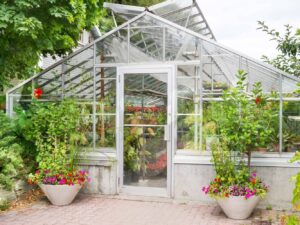Get Growing with a Greenhouse
It’s every gardener’s dream: a wonderful greenhouse that lets you extend the growing season long into winter, and enjoy fresh fruits, vegetables and flowers all year long. If you’re thinking about adding one to your yard, ask SESCOS about providing the power you’ll need to keep your greenhouse growing.
Elements of Growth
To nurture your seedlings and plants into full, vibrant life, think of your greenhouse as an ecosystem where everything works together.
- Horticultural lighting mimics the sun’s light.
- Temperature control lets your plants enjoy the varying warm and cool temperatures that help them grow strong.
- Humidity is vital to most plants, which thrive in humid, moist conditions.
- Many gardeners believe that music inspires plants to flourish–and studies back them up.
If you’ve noticed something that all of these elements have in common, it’s that they all need electricity to work. If you’re planning to enjoy the many benefits of a greenhouse, call SESCOS for expert advice on designing and installing the electrical wiring that will make your oasis come to life.
Designing and Building
What material is best for greenhouses?
- Wood is attractive and long-lasting but requires more maintenance than other materials.
- Aluminum is low-maintenance and doesn’t rust, but it also has a tendency to conduct coldness.
- Plastic is a good, low-cost choice but will wear out in a few years of exposure to the sun.
There are free greenhouse designs online that you can use to build your dream greenhouse or just get inspired.
Electrical Needs When Wiring a Greenhouse
Once you’ve got the greenhouse designed or built, you need to think about how you’ll run electricity to three necessary parts of any greenhouse:
- Lighting
- Coolers or fans
- Pumps for hot water systems and heaters
There are several things to consider when you’re wiring a greenhouse. Your best bet is to consult with a professional electrician who can look at your current system and help you answer the following questions.
1. Do you plan to run the wiring above the ground or below?
If you’re going to run the wiring overhead, you’ll be running electricity from the utility company’s poles and equipment. If you plan to bury the wiring, be careful with the placement of the wires and only use wires and plugs that are outdoor-rated.
2. Can your system handle the load?
Horticultural or “grow” lighting eats up a lot of electricity. The average small, backyard greenhouse generally requires about 30 amp to run all the necessary lights, fans and equipment. A large, multi-acre greenhouse farm will need from 100 to 200 amps.
Can your current system handle the amount needed? Consider installing a separate subpanel right in the greenhouse to ensure that your own system doesn’t get overloaded.
3. Are you permitted?
In some jurisdictions, a greenhouse requires a permit before you can start building. You also might need an electrical inspection. It’s best to find out now before you see your greenhouse and your garden dreams get torn down.
4. Are there energy-saving options?
In the past, gardeners had to rely on high-energy bulbs for horticultural lighting, but today you can choose low-energy compact fluorescent (CFL) lights or LED bulbs. Your SESCOS technician can help you choose the bulbs that will keep your plants healthy while saving you money on utility bills.
Green Options for Wiring a Greenhouses
You can cut down on the costs of running a greenhouse by installing smart detection and other features.
- Replace or retrofit your grow lights with LEDs.
- Purchase fans based on their energy-efficiency rating.
- Set the hot water heater at the lowest temperature that your plants need.
- Use smart sensors to turn the temperature in the greenhouse down at night.
- Add motion sensors to the security lights near your greenhouse.
Call SESCOS and Get Growing
If you’re ready to enjoy the many benefits of wiring a greenhouse, call SESCOS today. We’ll help you select the right wiring, install it safely and get you growing through every season.
